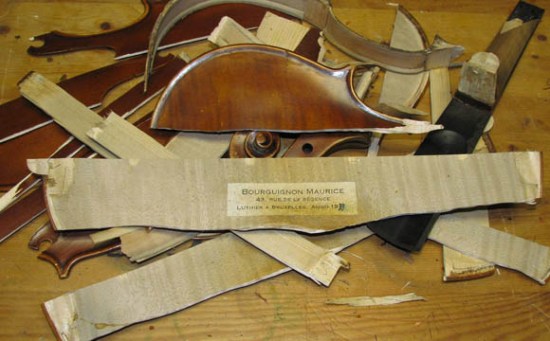To Settle Dispute, PayPal Orders Buyer to Destroy Violin
It started with the sale of a violin by Erica, with money exchanged via PayPal. The story goes awry when the buyer of the instrument complained to both Erica and PayPal that the violin was a fake — despite apparently being appraised by several experts. In a move echoing the wisdom of King Solomon, PayPal ordered the buyer to destroy the violin. As you can see above, that’s exactly what happened.
You might be wondering why PayPal would make such an apparently outrageous request. After all, destroying the merchandise means that Erica — the seller — no longer has her merchandise and has also lost the sale. In case you were curious, said sale was for some $2,500. According to the Register, PayPal was obliged to order the violin’s destruction because it is illegal to ship counterfeit goods in the U.S..
In fact, this stipulation is spelled out in PayPal’s terms of service.
While much of the case remains behind closed doors — notably, the specifics of the buyer’s claims of forgery and how he or she was able to substantiate said claims — an email written to Regretsy by Erica chronicles the affair. Interestingly, Erica writes in her letter that despite the accusations of counterfeiting, “there is no such thing in the violin world.”
In their report, the Register disagrees.
[…] experts like the American Federation of Violin and Bow Makers disagrees, noting that (for example) genuine Stradivarius instruments have all been accounted for, and saying that there are millions of fake Strads out there. A bit of Googling yields up plenty of individuals and organisations documenting the practise of label faking, and even tales of luthiers who collect dust from instruments given to them for repair, which can be used to give an impression of age to a new violin.
It’s worth noting that a recent study found that experts could not, simply from listening, tell the difference between a genuine Stradivarius violin and a fake.
Of course, it’s not quality of sound that is necessarily at issue here, rather the inherent value that a particular history imparts to an object. With that in mind, it seems tragic that this violin — which apparently survived the Second World War — was destroyed over a squabble. Fake or not, that’s a loss.
The full text of Erica’s letter follows below.
Dear Helen Killer
I love your site and was thrilled to hear of your “win” against PayPal. I recently had a heartbreaking experience of my own with them
I sold an old French violin to a buyer in Canada, and the buyer disputed the label
This is not uncommon. In the violin market, labels often mean little and there is often disagreement over them. Some of the most expensive violins in the world have disputed labels, but they are works of art nonetheless.
Rather than have the violin returned to me, PayPal made the buyer DESTROY the violin in order to get his money back. They somehow deemed the violin as “counterfeit” even though there is no such thing in the violin world.
The buyer was proud of himself, so he sent me a photo of the destroyed violin
I am now out a violin that made it through WWII as well as $2500. This is of course, upsetting. But my main goal in writing to you is to prevent PayPal from ordering the destruction of violins and other antiquities that they know nothing about. It is beyond me why PayPal simply didn’t have the violin returned to me.
I spoke on the phone to numerous reps from PayPal who 100% defended their action and gave me the party line.
Erica
(story and image via Regretsy, The Register, Thanks Estelle!)
Have a tip we should know? tips@themarysue.com
